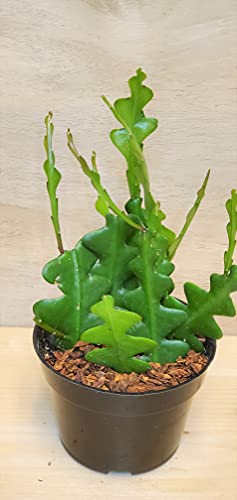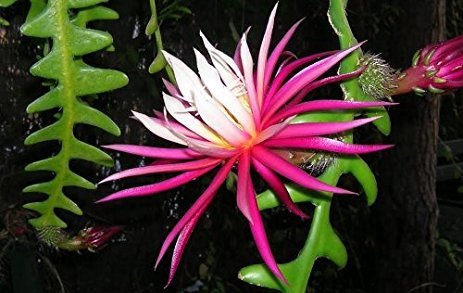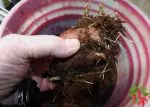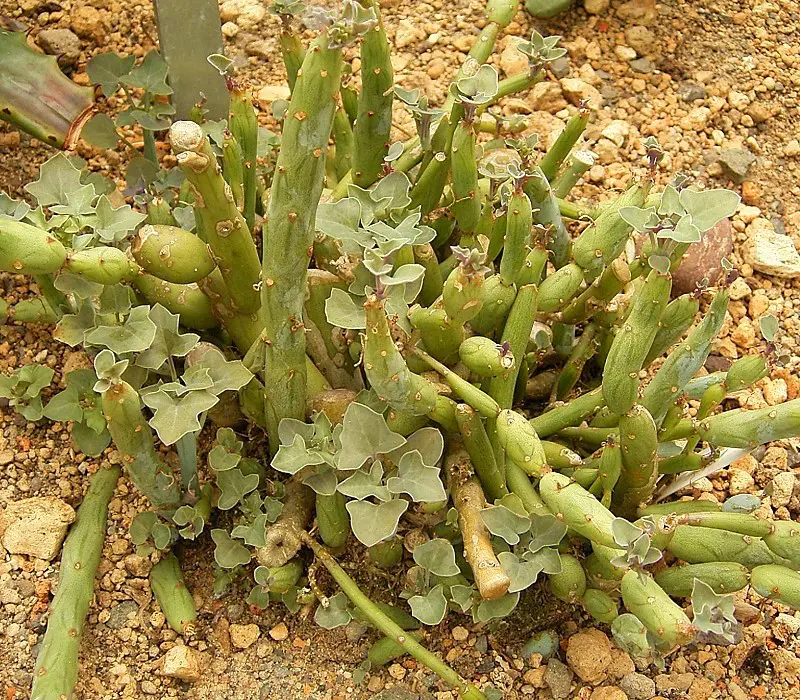This post contains affiliate links. If you buy something from one of our links we may earn a commission. Thanks
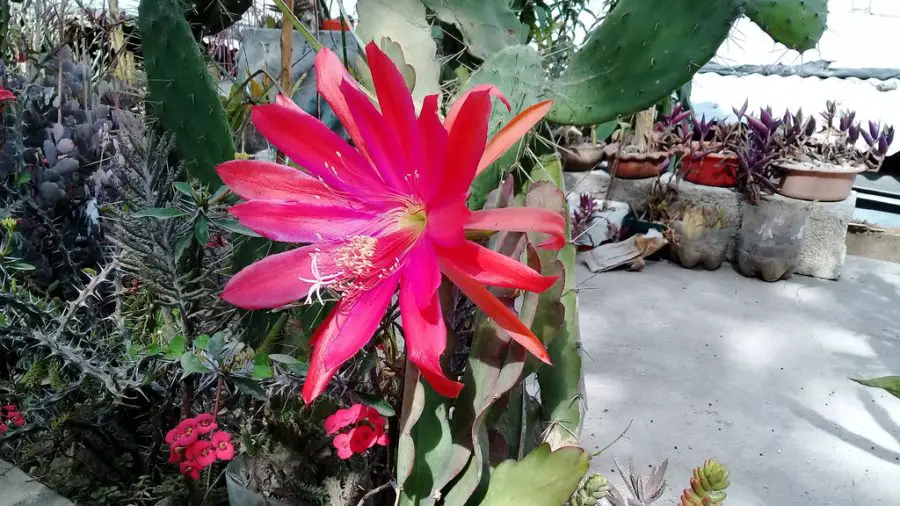
Discover the joy of fishbone cactus care with our easy-to-follow guide, packed with tips for helping your zig-zag cactus thrive in its new home.
Are you ready to dive into the fascinating world of fishbone cactus care?
This unique, eye-catching plant, also known as the zig-zag cactus, is a fantastic addition to any indoor space.
With its intriguing shape and enchanting, fragrant flowers, it’s no wonder this cactus is gaining popularity among plant enthusiasts.
In this comprehensive guide, we’ll explore everything you need to know to help your fishbone cactus flourish, from lighting to watering and beyond.
So, let’s get started on our fishbone cactus adventure together!
Fishbone Cactus (Disocactus anguliger) care involves placing the plant in indirect sunlight and maintaining moderate humidity. Water it when the top inch of soil feels dry to the touch. This cactus prefers well-draining soil and temperatures between 60-75°F for optimal growth. Fertilize monthly during the growing season.
What is Fishbone Cactus (Disocactus anguliger)?
Let’s kick things off by getting to know our star, the fishbone cactus (Disocactus anguliger).
This captivating plant, native to Mexico, is known for its distinctive, flat stems that zig-zag like a fish skeleton, hence its catchy name.
Not only does it boast an intriguing appearance, but it also delights with its nocturnal, fragrant flowers that bloom in the fall.
So, if you’re eager to learn more about this amazing cactus, you’ve come to the right place.
Keep reading, and we’ll uncover all there is to know about the fishbone cactus and its care!
General Facts About Fishbone Cactus
The fishbone cactus, or Disocactus anguliger, is an epiphytic plant, meaning it naturally grows on other plants, trees, or rocks without causing them harm.
This unique cactus hails from Mexico’s evergreen forests, where it thrives in the wild at elevations between 3,600 and 5,900 feet.
Fishbone Cactus Aerial Roots
A fascinating feature of the fishbone cactus is its aerial roots. These roots emerge from the plant’s stem and help it attach to surfaces, like tree trunks or rocks.
In an indoor setting, the aerial roots may seem a bit peculiar, but they’re just a natural part of this cactus’s growth and charm!
Fishbone Cactus Flower
One of the highlights of caring for a fishbone cactus is the enchanting flowers it produces.
These nocturnal blossoms open at night and exude a sweet, alluring fragrance.
Typically, the flowers are white or pale yellow and can be 2.4-7.9 inches long and 2.4-2.8 inches wide.
Enjoy them while they last, as they usually bloom in late autumn or early winter.
Fishbone Cactus Fruit
After the flowers have bloomed, the fishbone cactus produces small, ovoid fruits that are brownish, greenish, or yellowish.
The fruit’s interior resembles that of kiwifruit, with green pulp and tiny black seeds. Not only is the fruit visually appealing, but it’s also edible and quite tasty!
Fishbone Cactus Plant Size
The fishbone cactus can grow quite large, with secondary stems reaching lengths of 7.9-11.8 inches and widths of 1.2-2 inches.
The overall plant width can reach 3 feet making it an excellent candidate for a hanging basket.
These stems are flat, succulent, and deeply lobed, making them a real eye-catcher in any space. The primary stems may become woody as the plant matures.
Fishbone Cactus Blooming Time
As mentioned earlier, the fishbone cactus blooms in late autumn or early winter, bringing a delightful splash of beauty and fragrance to your home during the cooler months.
These nocturnal blooms are a reward for the careful attention and love you’ve given to your fishbone cactus throughout the year.
Fishbone Cactus Benefits
Now that we’ve learned more about the fishbone cactus, let’s talk about the incredible benefits this charming plant brings into our lives.
Not only does the fishbone cactus add a touch of visual interest to your space with its unique zig-zag stems, but it also has a knack for brightening up your home with its fragrant, nocturnal blooms.
Plus, it’s an air-purifying champ, working tirelessly to clean the air around it.
In this section, we’ll dive deeper into the wonderful advantages of incorporating a fishbone cactus into your indoor garden and explore how it can elevate your well-being and living space.
The Benefits Of Having A Fishbone Cactus In Your Home:
Aesthetically Pleasing: The unique zig-zag pattern of the fishbone cactus adds a touch of visual interest and a conversation starter to your indoor space. It’s sure to catch the eye of anyone who visits your home.
Fragrant Flowers: The fishbone cactus produces enchanting, nocturnal blooms that fill your home with a sweet, alluring fragrance, creating a pleasant and inviting atmosphere.
Air Purification: Fishbone cacti are known to help purify the air by absorbing pollutants like carbon dioxide and releasing fresh oxygen, contributing to a healthier indoor environment.
Low-Maintenance Care: This cactus is relatively easy to care for, making it an excellent choice for both seasoned plant enthusiasts and beginners.
Its low-maintenance nature means you can enjoy the beauty and benefits of the plant without too much hassle.
Edible Fruit: The fishbone cactus produces small, ovoid fruits that are not only visually appealing but also edible and tasty.
They offer a fun and unique addition to your homegrown fruit collection.
Stress Reduction: Caring for plants, including the fishbone cactus, can be a therapeutic and relaxing hobby.
Tending to your cactus can help reduce stress and promote a sense of well-being.
Boosts Creativity and Focus: Studies have shown that having plants in your living or working space can improve concentration, productivity, and creativity.
The fishbone cactus, with its striking appearance, can be an inspiring addition to your home or office.
By incorporating a fishbone cactus into your indoor garden, you’ll be reaping these fantastic benefits while also enjoying the process of nurturing this fascinating plant.
Fishbone Cactus Care In A Nutshell
So, you’ve decided to welcome a fishbone cactus into your home, congratulations! This delightful plant will bring you joy, beauty, and a host of benefits.
But, of course, you want to ensure that your new green friend thrives and flourishes under your care. Don’t worry; we’ve got you covered!
In this section, we’ll walk you through the basic essential steps and tips for fishbone cactus care.
From providing the right amount of light to watering and feeding, we’ll make sure you have all the knowledge you need to keep your fishbone cactus happy and healthy.
Further down in this post, we will cover fishbone cactus care in greater detail. Let’s embark on this exciting journey together!
Ideal Growing Environment
Creating the perfect environment for your fishbone cactus is key to helping it thrive.
Since it’s an epiphytic plant, it prefers a slightly different environment than your typical desert cactus.
Here are some aspects to consider when setting up your fishbone cactus’s new home:
Light: Fishbone cacti enjoy bright, indirect light. A spot near a window with filtered sunlight or a shaded area on a patio would be perfect.
Too much direct sunlight can cause sunburn or damage the plant’s delicate foliage.
Temperature: These cacti prefer temperatures between 50-85°F, with some tolerance for short dips in temperature.
Keep your fishbone cactus away from drafts or cold windows during the winter months.
Humidity: Fishbone cacti are native to humid environments, so they’ll appreciate higher humidity levels in your home.
Aim for around 40-60% humidity. You can achieve this by placing a humidifier nearby, using a pebble tray with water, or misting the plant regularly.
Tips for Success
To help your fishbone cactus flourish, follow these tips and tricks to ensure its well-being:
Watering: Allow the top inch of the soil to dry out between waterings. Overwatering can cause root rot, so it’s essential to find the right balance.
Reduce watering frequency during the winter months when the plant is dormant.
Soil and Potting: Use a well-draining soil mix, such as a blend of peat moss, perlite, and orchid bark.
Make sure to choose a pot with drainage holes to prevent waterlogging.
Fertilizing: Feed your fishbone cactus with a balanced, water-soluble fertilizer diluted to half-strength during the growing season (spring and summer).
Apply the fertilizer once a month to provide essential nutrients for growth and blooming.
Pruning and Maintenance: Regularly remove any dead or damaged stems to encourage healthy growth.
Pruning can also help maintain the desired shape and size of your fishbone cactus.
Repotting: Fishbone cacti enjoy being slightly root-bound, so you’ll only need to repot every 2-3 years or when the plant has outgrown its current pot.
Choose a pot that’s just one size larger than the current one, and use fresh, well-draining soil.
By following these guidelines and offering your fishbone cactus a loving, attentive touch, you’ll be well on your way to enjoying a thriving, beautiful plant for years to come.
Fishbone Cactus Light
When it comes to providing the right light for your fishbone cactus, you might be wondering what the sweet spot is for this unique plant.
After all, light is a crucial factor in its growth and overall health.
In this section, we’ll shed some light (pun intended!) on the ideal lighting conditions for your fishbone cactus.
We’ll discuss the best spots in your home to place your plant and how to ensure it receives the right amount of light to thrive.
So, let’s dive in and help your fishbone cactus bask in the perfect glow!
Optimal Light Conditions
Finding the perfect balance of light for your fishbone cactus will help it grow strong and healthy.
Here’s what you need to know about providing the right lighting:
Bright Indirect Light: Fishbone cacti love bright, indirect light.
Place your plant near a window that receives plenty of sunlight, but ensure that it’s filtered or diffused to avoid direct rays.
Sheer curtains or blinds can help soften the sunlight if needed.
Outdoor Shaded Area: If you live in a warmer climate and would like to keep your fishbone cactus outdoors, find a shaded area on your patio or balcony.
This will allow your plant to enjoy the warmth and fresh air without risking sunburn or damage from harsh sunlight.
Artificial Light: If your home doesn’t receive enough natural light, consider using artificial light sources like a LED grow light or fluorescent bulb.
These can provide the necessary light intensity for your fishbone cactus to grow and even bloom. Place your artificial light on a timer.
Signs of Inadequate Light
Just like any plant, a fishbone cactus can show signs of distress if it’s not receiving enough light.
Here are some indications that your cactus may need more light:
Leggy Growth: If your fishbone cactus starts to grow long, thin, and stretched-out stems, it might be searching for more light.
This is known as etiolation and is a common sign that your plant isn’t receiving enough light to support healthy, compact growth.
Lack of Blooming: One of the highlights of fishbone cactus care is the beautiful, fragrant flowers it produces.
However, if your plant doesn’t receive enough light, it may not bloom at all or produce fewer flowers than usual.
Pale or Yellowing Stems: If your fishbone cactus begins to look pale or the stems turn yellow, this could be a sign of too much direct sunlight.
Move your plant to a spot with more diffused or filtered light to prevent further damage.
By paying attention to your fishbone cactus’s light needs and making adjustments as needed, you’ll be well on your way to nurturing a vibrant, thriving plant that rewards you with stunning growth and blooms.
Temperature and Humidity
As a plant enthusiast, you already know that creating the ideal environment for your fishbone cactus is essential for its well-being.
Temperature and humidity play a significant role in keeping your plant happy and healthy.
In this section, we’ll discuss the ideal temperature range and humidity levels for your fishbone cactus, ensuring it feels right at home.
With our guidance, you’ll be well-equipped to create a comfortable environment for your fishbone cactus, allowing it to thrive and rewarding you with its stunning growth and blooms. Let’s get started!
Ideal Temperature Range
Keeping your fishbone cactus comfortable means providing it with the right temperature range.
Here’s what you need to know about maintaining the perfect climate for your plant:
Preferred Range: Fishbone cacti thrive in temperatures between 50-85°F.
They can tolerate some fluctuations, but it’s best to keep them within this range for optimal growth and health.
Avoid Extremes: Sudden temperature changes or extreme cold can harm your fishbone cactus.
Keep it away from drafty windows, air conditioning vents, or heating sources to avoid sudden temperature shifts.
Ideal Humidity Levels
Fishbone cacti appreciate a bit of humidity in their environment. Here’s what you should aim for to keep your plant happy:
Target Range: A humidity level of 40-60% is ideal for fishbone cacti. They are native to humid environments, so they’ll feel right at home with a bit of moisture in the air.
Monitor Humidity: Use a hygrometer to measure the humidity in your home, ensuring that it falls within the ideal range for your fishbone cactus.
Tips for Maintaining Optimal Temperature and Humidity
Creating the perfect climate for your fishbone cactus is easier than you might think.
Follow these tips to keep your plant in its ideal environment:
Group Plants: Placing your fishbone cactus near other plants can help increase humidity levels, as the plants release moisture through a process called transpiration.
Pebble Tray: Fill a shallow tray with pebbles and water, then place your fishbone cactus pot on top.
As the water evaporates, it’ll create a more humid microclimate around your plant.
Misting: Gently mist your fishbone cactus with water to increase humidity.
Be sure to use room-temperature water and a fine spray to avoid over-saturating the plant.
Humidifier: Consider investing in a humidifier if your home’s air is particularly dry.
This can help maintain consistent humidity levels for your fishbone cactus and other humidity-loving plants.
By keeping an eye on the temperature and humidity levels in your home, you’ll create a cozy, inviting environment for your fishbone cactus to grow and thrive.
Fishbone Cactus Watering
Watering your fishbone cactus might seem like a simple task, but it’s essential to get it just right to ensure your plant’s health and happiness.
In this section, we’ll dive into the art of watering your fishbone cactus, covering everything from frequency to the best techniques.
With our guidance, you’ll soon become a pro at quenching your plant’s thirst and helping it flourish.
So, let’s get ready to give your fishbone cactus the hydration it needs to thrive and show off its stunning foliage and blooms!
Watering Frequency
Finding the right watering schedule for your fishbone cactus is key to its well-being.
Here’s what you need to know to keep your plant properly hydrated:
General Rule: Allow the top inch of the soil to dry out between waterings.
This will help prevent overwatering and ensure that your fishbone cactus receives the right amount of moisture.
Seasonal Adjustments: During the winter months, your fishbone cactus will enter a period of dormancy, so it’s essential to reduce the watering frequency.
Keep an eye on the soil moisture and adjust your watering schedule accordingly.
Overwatering vs. Underwatering
Striking the right balance between overwatering and underwatering is crucial for your fishbone cactus.
Here’s how to distinguish between the two and find the perfect balance:
Overwatering: Giving your fishbone cactus too much water can lead to root rot and other health issues.
If the soil remains soggy or waterlogged, it’s a sign that you’re overwatering your plant.
Underwatering: On the other hand, if the soil is consistently dry and your fishbone cactus starts to show signs of distress, you might not be providing enough water.
It’s essential to find the right balance to maintain your plant’s health.
Signs of Improper Watering
Your fishbone cactus will show specific signs if it’s not receiving the proper amount of water. Here’s what to look for:
Overwatering Symptoms: Yellowing leaves, a mushy or rotten base, and a foul smell can all be indications of overwatering.
If you notice any of these signs, cut back on watering and let the soil dry out before watering again.
Underwatering Symptoms: Wrinkled or shriveled stems, slow growth, and drooping leaves can signal that your fishbone cactus is not receiving enough water.
Increase your watering frequency to help your plant bounce back.
By monitoring your fishbone cactus’s watering needs and adjusting your schedule as needed, you’ll help your plant grow strong and healthy, showcasing its captivating foliage and blooms.
Fishbone Cactus Soil and Pots (Coco Coir)
Selecting the right soil and pot for your fishbone cactus is just as important as providing proper light and water.
In this section, we’ll explore the best types of soil and pots to ensure your fishbone cactus thrives, with a special focus on coco coir as a fantastic option.
With our guidance, you’ll be well-prepared to give your fishbone cactus a cozy home where it can grow strong, healthy roots and showcase its stunning foliage and blooms.
So, let’s dig in and find the perfect combination of soil and pot for your beloved fishbone cactus!
Soil Requirements
To keep your fishbone cactus healthy, it’s essential to provide it with the right type of soil. Here’s what you should look for:
Well-Draining Mix: Fishbone cacti require a well-draining soil mix to prevent root rot and overwatering.
Look for a mix that contains ingredients like perlite, vermiculite, or sand to ensure proper drainage.
Organic Matter: As an epiphytic plant, the fishbone cactus thrives in soil with a high amount of organic matter.
Consider adding peat moss, bark, or compost to your mix for added nutrients and moisture retention.
Benefits of Using Coco Coir
Coco coir is an excellent choice for fishbone cactus soil due to its unique properties.
Here are some benefits of using coco coir:
Improved Drainage: Coco coir helps to improve soil drainage, preventing waterlogged roots and promoting overall plant health.
Moisture Retention: While it drains well, coco coir also retains moisture, ensuring that your fishbone cactus stays hydrated without becoming waterlogged.
Sustainability: Coco coir is an eco-friendly, renewable resource made from coconut husks, making it a sustainable choice for your fishbone cactus soil.
Choosing the Right Pot
Selecting the perfect pot for your fishbone cactus is crucial for its growth and well-being.
Here are some tips to help you make the right choice:
Drainage Holes: Choose a pot with drainage holes to prevent waterlogging and root rot.
This will allow excess water to escape and keep your fishbone cactus’s roots healthy.
Material: Consider using terra cotta or ceramic pots, as they allow for better air circulation and moisture evaporation.
However, plastic pots can work as well if you’re diligent about monitoring soil moisture.
Use in Hanging Baskets
Fishbone cacti are perfect candidates for hanging baskets due to their trailing growth habit.
Here’s what you need to know about using hanging baskets for your fishbone cactus:
Basket Material: Choose a hanging basket made from wire, plastic, or natural fibers. Ensure that it has drainage holes and is large enough to accommodate your plant’s growth.
Lining: Line your hanging basket with sphagnum moss, coconut fiber, or another material that helps retain moisture while still allowing for proper drainage.
Placement: Hang your fishbone cactus in a spot with bright, indirect light to showcase its unique foliage and encourage healthy growth.
By providing the right soil, pot, and environment for your fishbone cactus, you’ll create a nurturing home where it can grow and thrive, enchanting you with its captivating appearance and blooms.
Fishbone Cactus Fertilizer
Feeding your fishbone cactus the right nutrients is like giving it a gourmet meal, ensuring it has everything it needs to flourish and bloom.
In this section, we’ll delve into the world of fertilizers and discuss how to provide your fishbone cactus with the essential nutrients it craves.
From choosing the perfect fertilizer to knowing when and how much to apply, we’ve got you covered.
So, let’s learn how to nourish your fishbone cactus and help it grow strong, healthy, and ready to show off its captivating foliage and enchanting blooms!
Fertilizer Types and Frequency
Feeding your fishbone cactus with the right nutrients is crucial for its growth and well-being.
Here’s what you need to know about fertilizer types and frequency:
Balanced Fertilizer: Choose a balanced, water-soluble fertilizer with a formulation like 10-10-10 or 20-20-20, which provides equal parts of nitrogen, phosphorus, and potassium.
These nutrients support healthy foliage, root development, and flowering. Look for a fertilizer that also provides essential micronutrients in its formula.
Fertilizing Frequency: During the active growing season (spring and summer), feed your fishbone cactus once a month.
In the fall, reduce fertilizing to every other month, and in winter, when the plant is resting, you can skip fertilizing altogether.
Signs of Over-fertilization or Under-fertilization
Keeping an eye out for signs of over-fertilization or under-fertilization can help you maintain your fishbone cactus’s health.
Here’s what to look for:
Over-fertilization: Signs of over-fertilization include yellowing leaves, burned leaf tips, or a wilted appearance even when the soil is moist.
If you notice these symptoms, reduce the frequency and amount of fertilizer you’re using and flush the soil with water to remove excess salts.
Under-fertilization: If your fishbone cactus has slow growth, pale leaves, or reduced blooming, it may be under-fertilized or show a nutrient deficiency.
In this case, start applying a balanced fertilizer with trace minerals at the recommended frequency and observe the plant’s response.
By monitoring your fishbone cactus’s health and adjusting your fertilizing practices accordingly, you can ensure it receives the proper nutrients to grow strong, vibrant, and ready to captivate you with its stunning foliage and blooms.
Fishbone Cactus Propagation
Sharing the beauty of your fishbone cactus with friends or expanding your own collection has never been easier, thanks to its simple propagation process.
In this section, we’ll guide you through the steps to successfully propagate your fishbone cactus, turning a single plant into several gorgeous, thriving specimens.
With just a little patience and care, you’ll soon have new fishbone cactus plants to enjoy or gift to fellow plant enthusiasts.
So, let’s dive into the exciting world of fishbone cactus propagation and learn how to multiply the joy this unique plant brings!
Stem Cuttings Method
Propagating your fishbone cactus through stem cuttings is both simple and rewarding.
Here’s a step-by-step guide to help you through the process:
Prepare Your Tools: Gather a sharp, clean pair of pruning shears or scissors, a small pot with drainage holes, and a well-draining potting mix.
Take a Cutting: Choose a healthy stem from your fishbone cactus and make a clean cut, ideally 4-6 inches long. Remove any lower leaves or branches to leave a clean stem section.
Allow to Callus: Allow the cut end of the stem to dry and form a callus for 3-5 days. This helps prevent rotting when you plant the cutting.
Plant the Cutting: Fill the pot with potting mix and make a small hole for the cutting. Insert the callused end into the soil and gently firm the mix around it to provide support.
Provide Optimal Conditions: Place the pot in a location with bright, indirect light and maintain the same temperature and humidity conditions as the parent plant.
Water Sparingly: Water the cutting sparingly until you see new growth, indicating that it has rooted. Then, gradually increase watering to match the parent plant’s routine.
Tips for Successful Propagation
Follow these tips to ensure your fishbone cactus propagation is a success:
Patience is Key: Rooting can take anywhere from a few weeks to a couple of months, so be patient and give your cutting time to establish itself.
Avoid Overwatering: Too much water can lead to rotting, so water sparingly until the cutting has rooted and shows signs of growth.
Monitor Progress: Keep an eye on your cutting for signs of growth or any issues like pests or diseases.
Address any problems promptly to ensure a healthy, thriving new plant.
By following these steps and tips, you’ll soon have new fishbone cactus plants to enjoy, share, or add to your growing collection. Happy propagating!
Repotting Fishbone Cactus
As your fishbone cactus grows, it might need a roomier home to spread its roots and continue thriving.
In this section, we’ll walk you through the repotting process, making it as smooth and stress-free as possible for both you and your beloved plant.
Armed with the right tools and techniques, you’ll be able to give your fishbone cactus the space it needs to grow and flourish, ensuring its health and happiness for years to come.
So, let’s get ready to learn the ins and outs of repotting your fishbone cactus with confidence and ease!
When to Repot
Knowing when to repot your fishbone cactus is crucial for its continued growth and well-being.
Here are some indicators that it’s time for a new pot:
Rootbound: If you notice roots growing out of the drainage holes or wrapping tightly around the root ball, your fishbone cactus is likely rootbound and in need of a larger pot.
Outgrown the Pot: If the plant has grown significantly and appears top-heavy or unstable, it’s time for a bigger pot to provide more room and support.
Slowed Growth: If your fishbone cactus seems to have slowed down in growth or is struggling to absorb water and nutrients, it may be time for a new pot with fresh soil.
Steps for Repotting
Follow these steps for a successful repotting experience:
Choose a New Pot: Select a pot that’s 1-2 inches larger in diameter than the current one, with drainage holes to ensure proper water management.
Prepare the Pot: Fill the new pot with a well-draining potting mix suitable for cacti and epiphytes, leaving space for the root ball.
Remove the Plant: Gently remove your fishbone cactus from its current pot, taking care not to damage the roots.
If it’s stuck, try tapping on the sides and bottom of the pot to loosen the soil.
Inspect and Prune: Examine the root ball and trim away any damaged or dead roots. This is also a good time to remove any unhealthy stems or foliage.
Position the Plant: Place your fishbone cactus in the new pot, ensuring it’s sitting at the same depth as in the previous pot.
Fill in the remaining space with potting mix, gently firming it around the roots.
Water and Care: Water your repotted fishbone cactus thoroughly and place it in a bright, indirect light location.
Resume your regular care routine after a week, allowing the plant time to settle into its new home.
By following these guidelines for when to repot and the steps for repotting, you’ll provide your fishbone cactus with the space and environment it needs to continue thriving and gracing your space with its unique beauty.
Fishbone Cactus Maintenance and Pruning
A little love and care can go a long way in keeping your fishbone cactus healthy and looking its best.
In this section, we’ll explore the importance of regular maintenance and pruning, ensuring that your fishbone cactus remains a stunning focal point in your space.
With just a few simple tips and tricks, you’ll be able to keep your plant in tip-top shape, encouraging lush growth and beautiful blooms.
So, let’s dive into the world of fishbone cactus maintenance and pruning and learn how to keep your plant happy, healthy, and looking fabulous all year round!
Pruning Techniques
Maintaining your fishbone cactus involves a few simple pruning techniques that will help keep it healthy and looking great.
Here’s how to do it:
Gather Your Tools: Use clean, sharp pruning shears or scissors to ensure clean cuts and avoid the spread of disease.
Remove Dead or Damaged Growth: Trim away any dead or damaged stems, leaves, or flowers to encourage new, healthy growth and prevent the spread of disease.
Shape Your Plant: If your fishbone cactus is growing unevenly or looking unruly, trim back the longer stems to create a more balanced shape.
Control Size: If your plant is outgrowing its space, you can trim it back to keep it within the desired size range.
Benefits of Regular Pruning
There are several benefits to regularly pruning your fishbone cactus:
Encourage Healthy Growth: Pruning dead or damaged growth promotes overall plant health and encourages new, lush growth.
Prevent Disease: Removing unhealthy plant parts helps prevent the spread of disease and keeps your fishbone cactus in optimal condition.
Improve Appearance: Regular pruning maintains the desired shape and size of your fishbone cactus, ensuring it remains a beautiful focal point in your space.
Enhance Flowering: By pruning and maintaining your fishbone cactus, you can encourage better blooms, allowing you to enjoy its stunning, fragrant flowers.
By incorporating regular maintenance and pruning into your fishbone cactus care routine, you’ll keep your plant healthy, happy, and looking its best throughout the year.
Fishbone Cactus Problems
While the fishbone cactus is a resilient and low-maintenance plant, it’s not immune to the occasional problem.
In this section, we’ll discuss some common issues that may arise while caring for your fishbone cactus and how to address them effectively.
By understanding and recognizing these problems early, you’ll be able to keep your plant healthy and thriving.
So, let’s explore the potential challenges of fishbone cactus care and learn how to troubleshoot like a pro, ensuring your plant continues to be a gorgeous, eye-catching addition to your space!
Common Issues and Solutions
Caring for a fishbone cactus can come with a few challenges.
Here are some common issues and how to address them:
Yellowing or Wilting Leaves: This could indicate overwatering, underwatering, or inadequate light.
Adjust your care routine accordingly by allowing the soil to dry out slightly between waterings, providing more consistent moisture, or moving your plant to a brighter location.
Shriveled Stems: This may be a sign of underwatering. Ensure you’re watering your fishbone cactus consistently and providing the right amount of moisture.
Leggy Growth: If your plant is stretching or growing long, thin stems, it may be reaching for more light.
Move it to a location with brighter, indirect light to encourage compact growth.
Preventative Measures
To avoid common problems and keep your fishbone cactus in top shape, follow these preventative tips:
Monitor Watering: Be mindful of your plant’s water requirements and adjust your watering schedule accordingly to prevent overwatering or underwatering.
Provide Adequate Light: Ensure your fishbone cactus receives the right amount of light to promote healthy growth and prevent legginess.
Maintain Proper Humidity: Keep an eye on the humidity levels around your plant, as it prefers a slightly humid environment. Use a humidifier or other techniques to maintain ideal conditions.
Inspect Regularly: Regularly check your fishbone cactus for any signs of pests or disease, catching problems early and addressing them promptly.
By understanding common issues and implementing preventative measures, you’ll be able to maintain a healthy and thriving fishbone cactus, allowing it to continue gracing your space with its unique beauty.
Fishbone Cactus Pests and Diseases
Even the most attentive plant caretakers may occasionally encounter pests or diseases affecting their beloved fishbone cactus.
In this section, we’ll delve into the common pests and diseases that may trouble your fishbone cactus and share some practical solutions to help you manage these issues effectively.
With the right knowledge and tools, you can tackle these unwelcome guests and keep your plant healthy and thriving.
So, let’s uncover the potential threats to your fishbone cactus and learn how to keep it pest-free and flourishing!
Common Pests
Fishbone cactus may encounter a few common pests that can affect its health:
Mealybugs: These small, white, cottony insects suck sap from the plant, weakening it and potentially causing leaf drop.
They can also produce honeydew, which may lead to sooty mold.
Spider Mites: These tiny, spider-like creatures can cause yellowing or stippling of leaves, as well as webbing on the plant.
Severe infestations may result in leaf drop or plant death.
Scale Insects: Scale insects appear as small, immobile bumps on the stems and leaves of your plant.
They feed on plant sap, which can weaken your fishbone cactus and cause leaves to yellow or drop.
Common Diseases
Fishbone cactus can also be affected by a few diseases:
Root Rot: Overwatering or poorly draining soil can lead to root rot, which causes the roots to become mushy and dark. Affected plants may show yellowing leaves, wilting, or stunted growth.
Fungal Infections: High humidity or wet conditions can lead to fungal infections, which may manifest as spots on leaves, stem rot, or powdery mildew.
Treatment and Prevention
To combat pests and diseases on your fishbone cactus, follow these tips:
Monitor Your Plant: Regularly inspect your fishbone cactus for any signs of pests or diseases, and address issues promptly.
Use Insecticidal Soap or Neem Oil: If you spot pests on your plant, treat it with insecticidal soap or neem oil, following the label directions for application.
Improve Air Circulation: Ensure your fishbone cactus has adequate air circulation to prevent fungal infections and discourage pests.
Water Properly: Avoid overwatering and ensure your plant has well-draining soil to prevent root rot.
Maintain Cleanliness: Keep the area around your fishbone cactus clean and free of debris to reduce the risk of pests and diseases.
By being proactive in treating and preventing pests and diseases, you can keep your fishbone cactus healthy and thriving for years to come.
Fishbone Cactus FAQs
If you’re looking to add a unique and easy-to-care-for plant to your indoor collection, the Fishbone Cactus (Disocactus anguliger) is an excellent choice.
Its zigzag leaves are not just a visual delight but also an indicator of how adaptable and hardy this plant can be.
But how do you best care for a Fishbone Cactus? What kind of light does it need, and how often should you water it?
Let’s delve into these common questions to help you become a Fishbone Cactus pro.
Q: How do you take care of a Fishbone Cactus indoors?
A: Place your Fishbone Cactus in a spot with indirect sunlight and water it when the top inch of the soil feels dry. Make sure to use well-draining soil and keep the plant at a temperature range of 60-75°F.
Q: Does Fishbone Cactus need direct sunlight?
A: No, the Fishbone Cactus prefers indirect sunlight. Direct sunlight can scorch the leaves and cause stress to the plant.
Q: How often should you water a Fishbone Cactus?
A: Water your Fishbone Cactus when the top inch of soil feels dry to the touch. Overwatering can lead to root rot.
Q: Can Fishbone Cactus grow in low light?
A: While the Fishbone Cactus can tolerate low light conditions, it thrives best in indirect sunlight. Low light may result in slower growth and fewer blooms.
Fishbone Cactus Care Final Thoughts
As we wrap up our in-depth exploration of fishbone cactus care, we hope that you feel inspired and equipped to give your unique and captivating plant the best possible care.
Remember, it’s all about providing the right balance of light, water, temperature, and humidity, while also keeping an eye out for pests and diseases.
With the knowledge you’ve gained, you can ensure your fishbone cactus thrives and continues to be a striking addition to your home or garden.
So go ahead, embrace your inner green thumb, and enjoy the rewarding journey of caring for your stunning fishbone cactus!
Read more: Benefits Of Succulent Plants Indoors Plus They’re Easy To Grow




